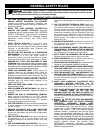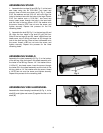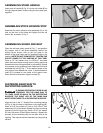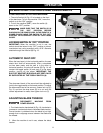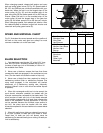
11
Fig. 13
AUTOMATIC SHUT-OFF
When the band saw is in the horizontal position, the saw
should shut itself off automatically. After a completed
cut has been made, and the saw is in the down or
horizontal position, the shut-off bracket (B) Fig. 14 will
contact the toggle switch (A) and push it to the down
position, turning off the power. IMPORTANT: THE
SHUT-OFF BRACKET (B) SHOULD NOT REST ON OR
BE SUPPORTED BY THE TOGGLE SWITCH (A).
The downward travel of the saw should be adjusted to
just trip the toggle switch at its lowest position. To adjust
the downward travel of the saw arm, loosen lock nut (C)
Fig. 15, and turn the stop screw (D) in or out until the
correct adjustment is made; then tighten lock nut (C).
Fig. 14
Fig. 15
ADJUSTING BLADE TENSION
DISCONNECT MACHINE FROM
POWER SOURCE.
1. Turn blade tension handwheel (A) Fig. 16, clockwise to
increase or counterclockwise to decrease blade tension.
Correct tension is obtained when the blade is just tight
enough that no slippage occurs between the blade and
the wheels.
2. When the machine is not in use, release the blade
tension.
Fig. 16
B
A
D
C
A
A
B
B
OPERATION
OPERATIONAL CONTROLS AND ADJUSTMENTS
STARTING AND STOPPING MACHINE
1. The on/off switch (A) Fig. 13 is located on the front
of the band saw. To turn the machine “ON,” move the
switch up to the “ON” position.
2. To turn the machine “OFF”, move the switch (A)
down to the “OFF” position.
MAKE SURE THAT THE SWITCH IS IN
THE “OFF” POSITION BEFORE
PLUGGING IN THE POWER CORD. IN THE EVENT OF A
POWER FAILURE, MOVE THE SWITCH TO THE “OFF”
POSITION. AN ACCIDENTAL START-UP CAN CAUSE
INJURY.
LOCKING SWITCH IN “OFF” POSITION
IMPORTANT: When the machine is not in use, the
switch should be locked
in the “OFF” position to prevent
unauthorized use,
using a padlock with a 3/16" diameter
shackle through the holes at (B) FIg. 13.




